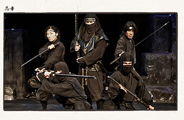There are many ways to enjoy Mount Fuji, but surely the main attraction is climbing it.
What are the charms of this mountain, which pulls in over 300,000 climbers each year?
Here are six aspects of the experience that Mount Fuji offers.
The 6 Charms

 The Impressive Goraiko
The Impressive Goraiko
The sunrise viewed from the top of a mountain is referred to as goraiko, a term which expresses a sense of gratitude for the spectacle. Goraiko as seen from the summit of Mount Fuji, the very highest point in Japan, is exceptional! There are so many climbers who seek goraiko that viewing spots become extremely crowded around daybreak.

 The Mysterious Kagefuji
The Mysterious Kagefuji
Kagefuji refers to the phenomenon in which Mount Fuji receives sunlight and its beautiful form is reflected in shadows at the base of the mountain and in the clouds. It can't be seen unless weather conditions and locations (of clouds, etc.) line up just right. It is another incarnation of Mount Fuji, encountered only by lucky climbers.

 The Extensive Panorama from the Summit
The Extensive Panorama from the Summit
The summit of Mount Fuji, which rises over 3,700 meters in elevation, is far above the clouds. Depending on the weather, you can enjoy a variety of views, including the world below stretching out before you and a sea of clouds extending into the distance.

 Vitality One Can Only See in an Active Volcano
Vitality One Can Only See in an Active Volcano
At the top of Mount Fuji, which is an active volcano, there is an enormous crater resulting from eruptions. Walking around this crater is known as ohachi meguri, and it has become a popular trekking course. This peak, called "Kengamine," comprises a course of approximately 3km and reaches up to 3,776m in elevation!

 Mount Fuji’s Religious Mecca
Mount Fuji’s Religious Mecca
The shrine at the summit is the rear shrine of "Fujisan Chojo Sengen Taisha." "Fujisan Chojo Sengen Taisha" is the main shrine of the "Asama Shrines," which are said to number around 1,300 locations. You can truly feel the worship that the people of Japan have long held for Mount Fuji.

 The Various Sights on the Ascending and Descending Paths
The Various Sights on the Ascending and Descending Paths
From the lush greenery around the Gogome area, rough rocky portions increase the further up one goes. Depending on the area, one can see alpine flora, sandy areas, and snowy gorges. There are multiple routes, so repeat visitors can have a fresh experience each time.
The 3 Hazards

 More UV Rays than a Beach
More UV Rays than a Beach
Your body is showered with more UV rays the further up you go. Besides a hat and sunglasses, you may want to prepare goods to protect you against UV rays, such as sunblock. Also be careful not to get altitude sickness.

 Colder than One May Expect...
Colder than One May Expect...
Even in the summer, the temperature at the summit is around 6 degrees Celsius, as if it were the middle of winter. At 18 degrees, the average temperature of Gogome is lower than you may imagine as well. Your body temperature is particularly prone to drop in times of strong winds and heavy rain, so be sure to exercise adequate caution.

 It’s Easy to Slip
It’s Easy to Slip
There are many rocky and gravelly roads on the trail, so it may be difficult to keep your footing. Instead of the sneakers you wear around town, it's safer to wear trekking shoes. We also recommend that you bring a trekking pole.
Mount Fuji Climbing Tales
Over 1,300 years ago?!
There is a rumor that the historical figure "Shotokutaishi" rode a horse up the mountain. It's also said that a mountain hut on Yoshida Route Hachigome called "Taishikan" got its name from a legend that Shotokutaishi rested at this spot during his journey.
The first foreign climber came about 150 years ago.
The first foreign climber was Sir Rutherford Alcock, the first British minister to live in Japan. A monument in his honor stands at Fujinomiya Route Gogome.
The oldest climber was over 100 years old.
Inside of the "Gogoen Rest House" at Fuji Subaru Line Gogome, there is a statue of Teiichi Igarashi, a man who climbed Mount Fuji at the age of 105 years old!
Choosing a country will allow you to access local content and enable you to shop in your local currency.

























